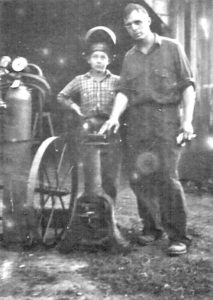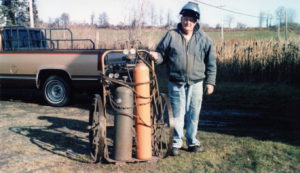Growing up in Honeoye Falls in the 1940s
by Tom Sargeant – with an afterword from his brother, Bob Sargeant. –
We lived at 43 North Main Street. The house is still there. Next door lived an old man who on the 4th of July would bring out a portable crate with his rocket launcher on it. He could send a portable rocket across the street and over the American Legion Hall. There were no fireworks allowed (or available) after 1941.
In 1942, after World War II started, we began working for the local farmers. We did field work, picking up potatoes and corn (we had to shuck it), and gladiola bulbs and we detasseled corn. We went to school a bit earlier and were let out after noon. The farmers would send a truck by to pick us up and take us to the field where we would be working.
The first job I had was for the Moses Nursery in Lima, NY. We picked up gladiola bulbs and he paid us $.45 and hour. We picked up potatoes and picked up and shucked corn. We were paid 10 cents per bushel. For a full day’s work on Saturday, you could make $5.00. We picked corn for K.C. Livermore. He was hard work too. We picked up potatoes for Chauney VanVoorhis. He paid us 10 cents a bushel and his potatoes were large.
At the Harwood Martin farm we detasseled corn; detassel (4) rows and leave the tassels on two. He paid us better than the other farmers. The farmers always paid us up at days end, in cash.
The Birds-Eye Snyder Factory in Avon, NY hired a team of ten of us from the high school. They also hired the school coach to be our leader. Our coach was Lou Basil at the time. He later became the coach at Thomas Aquinas in Rochester. We would be picked up in the company truck and be transported to the field we were to work in. We got this work because the parent of one of the students was the Vice-President at Birds-Eye.
Our principal had a Victory (produce) Garden. My brothers and a few other kids worked here. We weeded onions and carrots. My oldest brother and I and the other big kids were paid 30 cents and hour. My brother Bob, who was a bit smaller, was paid 25 cents and hour. Bob worked just as hard as the rest of us.
In the year 1942, after the war started, I collected one ton of scrap iron from Honeoye Creek. This was part of the war effort at the time. I received a “V” for Victory from my school. The letter “V” had a number 42 on it. My mother sewed it on a sweater for me.
We also collected cardboard and newspapers from the local stores in the village. We bundled them up and sold them to the scrap men for 3 cents per pound. Additionally we collected milkweed pods. The filmy matter was used in life vests and jackets to keep flight crews and Navy men afloat.
 1942 was also the year my father taught me to weld. I was just 9 years old. I worked in my father’s shop from time to time. Later on in 1946 my father got a contract to modify water tanks in a number of schools in Western New York. Two of these schools, one in Nunda, NY and one in Canaserega, NY, NY were worked on our first day on the job. After we finished the work that day we were returning home by way of Dansville, Hill. We had to go down a long steep hill. My father was worried about getting down. We had an old International pick up truck with mechanical breaks. We started down the hill and dad shut the engine off and put the truck in low gear. By the time we got to the bottom of the hill we were going 50 mile per hour. Wow! Whew!
1942 was also the year my father taught me to weld. I was just 9 years old. I worked in my father’s shop from time to time. Later on in 1946 my father got a contract to modify water tanks in a number of schools in Western New York. Two of these schools, one in Nunda, NY and one in Canaserega, NY, NY were worked on our first day on the job. After we finished the work that day we were returning home by way of Dansville, Hill. We had to go down a long steep hill. My father was worried about getting down. We had an old International pick up truck with mechanical breaks. We started down the hill and dad shut the engine off and put the truck in low gear. By the time we got to the bottom of the hill we were going 50 mile per hour. Wow! Whew!

I was run over by a car two days before Thanksgiving in 1940, while a bully was chasing me. I was 7 years old.
Growing up in Honeoye Falls in the 1940’s was the greatest place to be at the time. Some of the entertainment was going to Rochester Junction to watch the Lehigh Valley’s Black Diamond Train (a new diesel at the time). My father had worked on the Lehigh Valley as a boy.
We barely had a radio –no T.V. for us until 1949 or 1950.
Life was great – we had a lot of time to be and learn on our own.
Brother Bob and I also put the chairs up for the Saturday night band concert at the Harry Allen Park. Uncle Alex would give us each 50 cents. We would go to the movies for 18 cents and a soda after the movie was 15 cents at that time. We had to go back after the movie and put the chairs away, turn out the lights and lock the door.
Some notes from Bob Sargeant to accompany his brother Tom’s story.
1939 – The family made a motor trip to Rutland, Vermont to visit Aunt Anna. She owned the house at 43 N. Main Street. I remember visiting the Marble quarry and Lake Bomoseen. Aunt Anna and her husband had a sailboat. The kids didn’t get to go.
1939 – I was in kindergarten at Mrs. Carey’s, [she lived] two houses up the street, closer to the village center.
1943-45 – We worked the fields. School was out by noon. By 1:30 we were picked up and were in the fields.
Late 1940’s – Near LeRoy, NY we went to an air show at the Woodward Airport, a private family owned airport owned by the owners of the Jell-O factory in LeRoy. Also near LeRoy was where Circular Hill Road jalopy races were held. This was a natural amphitheater – people sat on the grassy hillside. The jalopy vehicles had no windshields. At these races a hot air balloon was inflated and allowed to drift up and away. This all seemed so exciting at the time.
Tom mentioned barely having a radio. There were a few stations available but not 24 hour programming like we have today. Listening to the radio was a daily ritual, especially at dinnertime – Jack Armstrong (The All-American Boy), Captain Midnight (send a box top in for the secret code ring). We did this, of course, and waited anxiously for the ring in the mail [Captain Midnight was on the radio from 1938-1947]. There was also Terry and the Pirates. There was the Green Hornet and later in the evening we listened to Gang Buster and Inner Sanctum (What mystery lies behind the squeaky door?).
Summer days were spent outdoors in Honeoye Falls. Down at the creek swimming, turning rocks over for bait and sometimes fishing. We covered great distances on the creek. In the woods behind the house we had a rope swing in a walnut tree. On a rainy day we would make a dam in the culvert in front of the house.
Summer evenings we might get enough kids together to play softball, tag or capture the flag. This would take place in the park downtown. I ran into a flag [pole] playing tag.
Winter days [were spent] ice skating on the creek, skiing down a hill or in the street. Maplewood Avenue was a side street and nice hill to use our sleds on. I remember once skating on the road surface as black ice made it possible.
Summers we mowed lawns and raked leaves. Winters we shoveled snow from the sidewalks and driveways.
A last thought. There was a barn on the property, down a long drive behind the house. My dad used part for his workshop. He repaired farm equipment and made plow points for farms. The barn also had a stable for horses and an apple dryer. I remember climbing up the apple dryer and onto the roof through a cupola. From the roof my brother Jack would launch his model airplanes. Some of us kids would try smoking. We somehow started a fire in the barn. The fire department was called and the fire engine came down the driveway to put out the fire. It was really exciting to have the firemen and equipment come to our house. [Editor’s note: In a follow up converstaion with Tom Sargeant, he shared that this was a bit of a “smokers’ club” and that they would get Bugler tobacco and roll it with a hand rolling machine. “The neighbor’s call to the fire department,” he added, “put an end to the smokers’ club.”]
That barn was also used for a carnival we put on one time. There was a haunted house, costume show and games. Many kids came for the event. Some kids told me later that they were disappointed we only did it that one time. The house [43 North Main Street, Honeoye Falls, NY] and the barn were a great place to be during those years.
Editor’s note: Tom Sargeant (b. May 20, 1933) and his family, including his brother Bob Sargeant (b. August 2, 1934), grew up in Honeoye Falls, NY. Tom Sargeant learned to weld from his father, John Sargeant. Metal work remained his lifelong vocation. He founded Sargeant’s Ornamental Iron Works in 1968, and owned and operated the business with his wife Virginia until their retirement. Sargeant’s Ornamental Iron Works was housed on a former grain mill site on Richmond Mills Road, near the former location of the Lehigh Valley Railroad’s Richmond Mills Depot. The Depot served passengers for a daily train that ran between Hemlock to Henrietta, NY from 1895 through the mid-30s. Tom Sargeant and his wife Virginia still live on the historic site.